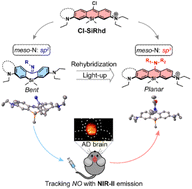Bent-to-planar Si-rhodamines: a distinct rehybridization lights up NIR-II fluorescence for tracking nitric oxide in the Alzheimer's disease brain†
Abstract
An ongoing revolution in fluorescence-based technologies has transformed the way we visualize and manipulate biological events. An enduring goal in this field is to explore high-performance fluorogenic scaffolds that show tunability and capability for in vivo analysis, especially for small-molecular near-infrared (NIR) fluorophores. We present a unique bent-to-planar rehybridization design strategy for NIR fluorogenic scaffolds, thus yielding a palette of switchable bent/planar Si-rhodamines that span from visible to NIR-II wavelengths. We demonstrate that the rehybridization of meso-nitrogen in this innovative NIR scaffold Cl-SiRhd results in flipping between the disruption and recovery of the polymethine π-electron system, thereby significantly altering the spectral wavelength with crosstalk-free responses. Using elaborately lighting-up NIR-II probes with ultra-large Stokes shifts (ca. 250 nm), we successfully achieve real-time in situ monitoring of biological events in live cells, zebrafish, and mice. Notably, for the first time, the light-up NIR-II probe makes a breakthrough in directly in situ tracking nitric oxide (NO) fluctuations in the brains of mice with Alzheimer's disease. This de novo bent-to-planar rehybridization strategy of NIR-II probes opens up exciting opportunities for expanding the in vivo imaging toolbox in both life science research and clinical applications.

- This article is part of the themed collection: Most popular 2023 analytical chemistry articles


 Please wait while we load your content...
Please wait while we load your content...